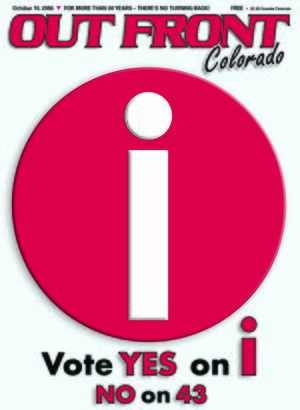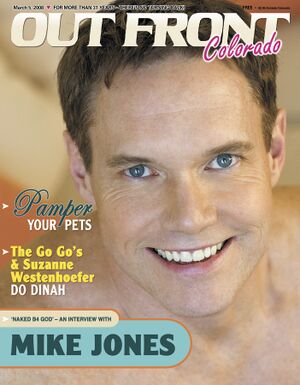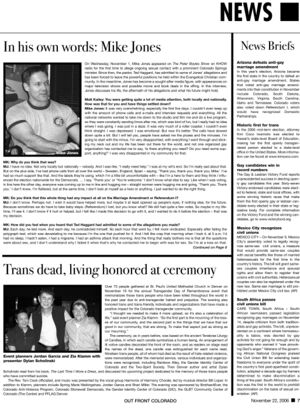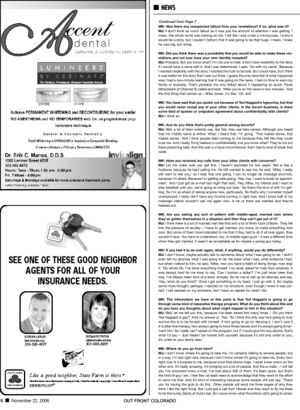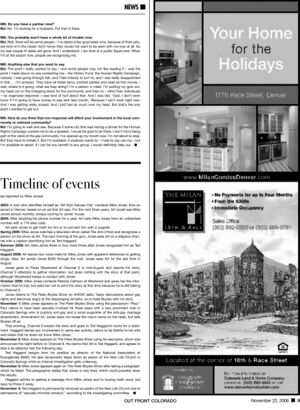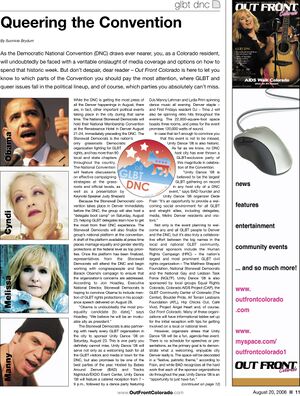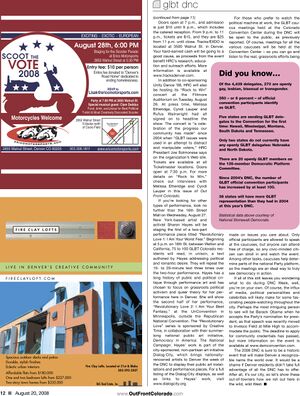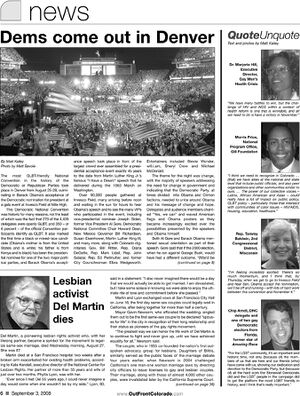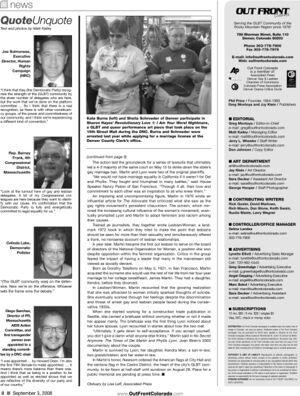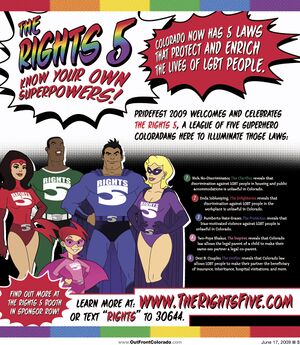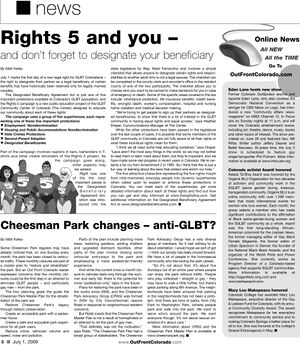Out Front Colorado: The 2000s - Marching on
Yes on I, No on 43
November 22, 2006: Attorney Pat Steadman: “Colorado voters declined the opportunity to become the first in the nation to extend basic legal protections to same-sex couples by popular vote.”[1]
Colorado has the distinction of being the first state to have both an anti-same-sex-marriage amendment (Amendment 43) and a domestic partnership referendum (Referendum I) on the same ballot – in November 2006 – and since the two issues were separate, voters had several options.
Coloradans could choose to vote in favor of both, signaling their support for domestic partnerships but their opposition to same-sex marriage. They could vote against both, signaling their opposition to both domestic partnerships and to enshrining discrimination into the Colorado Constitution. They could vote in favor of Referendum I and against Amendment 43, which is what Out Front Colorado and the LGBT community hoped they would do. Or they could vote in favor of Amendment 43 and against Referendum I, which is what they did.
Unfortunately, many residents of the City and County of Denver, who leaned heavily in favor of Referendum I, were disenfranchised when the new voting system that Denver implemented at this election turned out to have major flaws, leaving voters standing in line for hours and causing thousands to walk away without voting. Although it did not appear that the referendum would have passed, even if everything had gone smoothly, many were angry and upset that their voices were not heard.[2]
Ted Haggard outed
And then there was Mike Jones. Just a few days before the election, Denver masseur and escort Mike Jones announced to the media that Ted Haggard, founder and pastor of the New Life Church in Colorado Springs, friend to James Dobson of Focus on the Family and outspoken anti-gay activist, had been an ongoing client of his, and that their interactions involved sexual relations and Jones procuring methamphetamine for Haggard.
Timeline of events (as reported by Mike Jones)
2003: A man who identifies himself as “Art from Kansas City” contacts Mike Jones, then an escort in Denver, based on an ad that Art saw. For the next three years, Art would see Mike Jones almost monthly, always coming to Jones’ house.
2004: After blocking his phone number for a year, Art calls Mike Jones from an unblocked number with a 719 area code.
Art asks Jones to get meth for him or to connect him with a supplier.
Spring 2006: Mike Jones watches a television show called The Anti-Christ and recognizes a person on the show as Art. The next morning at the gym, Jones sees Art on a religious channel with a caption identifying him as Ted Haggard.
Summer 2006: Jones sees Art three or four more times after recognizing him as Ted Haggard.
August 2006: Art leaves two voice mails for Mike Jones with apparent references to getting drugs. Also, Art sends Jones $200 through the mail. Jones sees Art for the last time in August.
Jones goes to Paula Woodward of Channel 9 in mid-August and reports his story. Channel 9 attempts to gather information, but does nothing with the story at that point, although Woodward keeps in contact with Jones.
October 2006: Mike Jones contacts Patricia Calhoun at Westword and gives her the information that he has, but asks her not to print the story at that time because he is still talking to Channel 9.
Jones listens to The Peter Boyles Show on KHOW radio, hears discussions about gay rights and becomes angry at the disparaging remarks, so e-mails Boyles with his story.
November 1: Mike Jones appears on The Peter Boyles Show using the pseudonym “Paul.” Paul claims to have been sexually involved for three years with a very prominent man in Colorado Springs who is publicly anti-gay and a vocal supporter of the anti-gay marriage amendment, Amendment 43. Jones does not reveal the man’s name on the radio, but tells Boyles off-air.
That evening, Channel 9 breaks the story and goes to Ted Haggard’s home for a statement. Haggard denies any involvement in same-sex activity, claims to be faithful to his wife and states that he does not know Mike Jones.
November 2: Mike Jones appears on The Peter Boyles Show using his real name, which was announced the night before on Channel 9. He claims that Art is Ted Haggard, and agrees to take a lie-detector test the following day.
Ted Haggard resigns from his position as director of the National Association of Evangelicals (NAE). He also temporarily steps down as pastor of the New Life Church in Colorado Springs while an internal investigation gets underway.
November 3: Mike Jones appears again on The Peter Boyles Show after taking a polygraph, which he failed. The polygrapher states that Jones is very tired, which could possibly skew the results.
Haggard admits to getting a massage from Mike Jones and to buying meth once, but says he threw it away.
November 4: Ted Haggard is permanently removed as pastor of the New Life Church due to admissions of “sexually immoral conduct,” according to the investigating committee.[3]
Some people blamed Mike Jones for the defeat of Referendum I, believing that tales of sex and drug use, particularly with an Evangelical minister, cooled voters on the idea of equal rights for the gay community.
November 22, 2006: Mike Jones: “I wish it would have helped more, but maybe it at least opened up people’s eyes, if nothing else, for the future. Because sometimes we do have to take baby steps. [Referendum] I lost, but you know what? We still had quite a few votes. So maybe in my lifetime, I’ll see it. I don’t know if it [outing Ted Haggard] hurt or helped, but I felt like I made this decision to go with it, and I wanted to do it before the election – that was my decision.”[4]
But even with the constitutional amendment banning same-sex marriage, the state would send the first openly gay freshman senator in history, Jared Polis, to Washington, D.C. But first, Colorado played host to LGBT-friendliest Democratic National Convention in history.
The DNC – Queering the Convention
The local and national LGBT community came together to host an unprecedented number of events during the DNC, including the Stonewall Democrats National Convention; the Unity Dance, which welcomed out-of-state LGBT visitors and media and was believed to be the largest LGBT gathering on record in any host city of a DNC event; the Human Rights Campaign’s Rock to Win concert, featuring Melissa Ethridge, Cyndi Lauper and Rufus Wainwright; performance artist Sharon Hayes’ “Revolutionary Love 1: I Am Your Worst Fear,” which enlisted close to 100 LGBT Colorado residents for a public reading; and LGBT caucuses, meetings, presentations and gatherings throughout the convention.[5]
Convention attendees cheered when both Democratic presidential nominee Barack Obama and former Vice President Al Gore acknowledged the gay and lesbian community in their speeches at the nomination gala.
“I know there are differences on same-sex marriage,” Obama said, “but surely we can agree that or gay and lesbian brothers and sisters deserve to visit the person they love in the hospital and to live lives free of discrimination.”[6]
The DNC gave LGBT visitors to Colorado a very different picture of the state than they had in the wake of Amendment 2. And over the next two years, Colorado’s newly Democrat-majority state legislature – with the help of out Sen. Jennifer Veiga and out Rep. Mark Ferrandino – would pass five important laws that benefit LGBT people in the state.
The Rights Five
On April 22, 2009, Colorado made history as the first state to bring a hate-crimes verdict against a defendant in the murder of a transgender person. Greeley trans woman Angie Zapata was brutally murdered on July 17, 2008. Allen Andrade was arrested on July 30 and charged with first-degree murder and a hate crime in her murder. Many activists felt that Weld County district attorney Ken Buck, a conservative Republican, risked his political career to argue for a hate-crimes finding in the case. But while most activists celebrated the historic verdict, there were those who believed that Colorado’s bias-motivated crimes legislation endangered marginalized populations, and Out Front Colorado presented both views in the July 29, 2009 issue.[7]
On July 1, 2009, the LGBT community had another reason to celebrate when all Coloradans – including LGBT residents – gained the right to designate a related or unrelated adult as a legal beneficiary of certain benefits that have historically been reserved only for legally married couples.[8]
The Designated Beneficiary Act was the last of five LGBT-friendly laws passed by the Colorado legislature. The others included employment non-discrimination, housing and public accommodations non-discrimination, second-parent adoption and the bias-motivated crimes legislation.
In an effort to educate LGBT Coloradans about the laws that protect their rights, the GLBT Community Center of Colorado unveiled The Rights Five, a campaign using superheroes to build awareness of these laws. With a build-your-own-superhero Web site and a visible presence at Denver PrideFest, The Rights Five campaign helped bring same-sex couples to their local Clerk & Recorder office on July 1 to file their Designated Beneficiary paperwork.[9]
<comments />
References:
- ↑ Pat Steadman, "Moving beyond Referendum I," Out Front Colorado, November 22, 2006.
- ↑ Pat Steadman, "Moving beyond Referendum I," Out Front Colorado, November 22, 2006.
- ↑ Matt Kailey, "In his own words: Mike Jones," Out Front Colorado, November 22, 2006.
- ↑ Matt Kailey, "In his own words: Mike Jones," Out Front Colorado, November 22, 2006.
- ↑ Sunnivie Brydum, "Queering the Convention," Out Front Colorado, August 22, 2008.
- ↑ Matt Kailey, "Dems come out in Denver," Out Front Colorado, September 3, 2008.
- ↑ Matt Kailey, "Two sides to hate crimes legislation," Out Front Colorado, July 29, 2009.
- ↑ Matt Kailey, "Rights 5 and you," Out Front Colorado, July 1, 2009.
- ↑ Matt Kailey, "Designated Beneficiary Agreement Act in effect," Out Front Colorado, July 15, 2009.
